#(which are typically the size of an average human adult)
Explore tagged Tumblr posts
Text
Wet Beast Wednesday: whale shark
So I may have committed a cardinal sin last week because I didn't realize it was shark week and instead of a shark, I covered hagfish. This was clearly a terrible oversight and to make up for it, I'm going to talk about the biggest shark of all: the mighty whale shark.
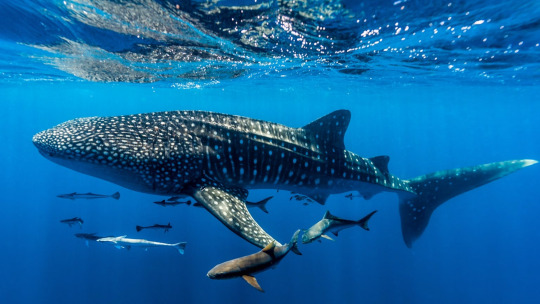
(Image: a whale shark seen from the side. It is a very large shark with a flattened head and three ridges running down its side. The skin in grey and covered in white spots. Smaller sharks and remoras are swimming alongside it. End ID)
Whale sharks (Rhincodon typus) are carpet sharks, meaning they are members of the order Orectolobiformes. The carpet sharks most people are familiar with are the wobbegongs, who are ventrally flattened sharks they typically stick near the seafloor, but Orectolobiformes is a pretty diverse clade containing a large variety of sharks with diverse body plans. Whale sharks are the only living member of the family Rhinocodontidae, making them effectively cousins of the wobbegongs. While there is only one living species of whale shark, we know of another few in the fossil record and there were likely more extinct species and relatives that we don't know about. Because shark skeletons are made of cartilage, they rarely fossilize, leaving only their teeth as fossils. Whale sharks have very tiny teeth and smaller things are less likely to fossilize than large things. Add in that fossilization is very rare and it's very possible there were whale sharks and other similar things in the past we will never know about because they never fossilized.
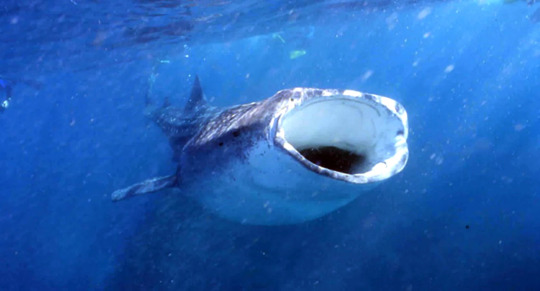
(Image: a whale shark seen from the front. Its mouth is open, very wide, and apparently toothless. End ID)
Whale sharks are the largest living sharks and the largest living animals that aren't whales. Whale sharks can reach an average adult size of 14.5 meters (48 ft) and 18,600 kg (41,000 lbs), with males being larger. The largest whale shark on record was measured to be 18.8 m (62 ft). Whale sharks have broad, flattened heads and unlike most sharks, their mouths are on the front of the head instead of beneath the snout. The mouth can be over 2 meters across in an adult and is lined with approximately 300 rows of tiny teeth. These teeth are vestigial and do not play a role in feeding. Instead, the shark uses a structure at the back of the mouth composed of 20 fleshy pads that are coated with a thin mesh and held in place with connective tissue. More on feeding below. Whale sharks are grey in color, with white bellies and white spots covering the body. Each whale shark has a unique pattern of spots that scientists can use for identification. The spots will reappear in areas where damaged skin has healed instead of being scarred over. Whale sharks also have some regenerative ability, being able to recover from major wounds and possibly regrow sections of lost fin. Each side of the body has three long ridges that may help with streamlining.
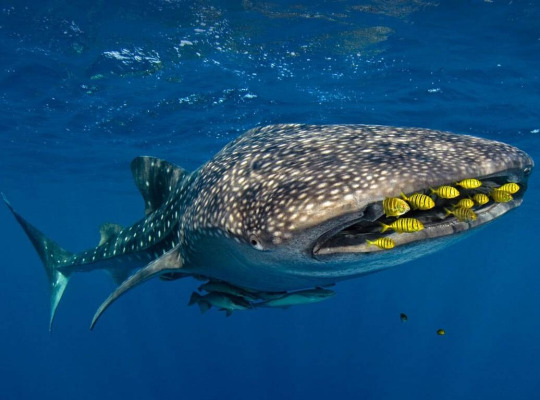
(Image: a whale shark seen form the front with its mouth closed. There are remoras attached to its underbelly and a group of small yellow fish with black stripes swimming near the mouth, possibly acting as cleaner fish. End ID)
Whale shark skin can be up to 15 cm thick and is covered with tiny, tooth-like scales called dermal denticles. Having tiny teeth where bony fish have scales is normal for sharks. What is not normal is having them on your eyes, but the whale shark does anyway. Let me repeat: whale sharks have teeth on their eyeballs. I like body horror and I'm creeped out by that. The eyes can be retracted into the head and these two adaptations are believed to protect the eyes from predators and parasites. Another adaptations the eyes (which, again, HAVE TEETH ON THEM) have is a mutated version of rhodopsin, the pigment the rod sells of the yes use to see. this mutation makes the eyes good at seeing blue light, but the rhodopsin becomes unstable in warm temperatures. In humans, this mutation leads to a degenerative eye condition that can result in blindness. Whale sharks have a solution, though. When in warm, shallow water, the pigment can be turned off to keep the eyes from degenerating. When the shark dives to deep water, the pigment is reactivated, granting the shark better vision as blue light is the most common in the deep sea.

(Image: a close-up of a whale shark eye. It is a small, black, lidless eyeball surrounded by gray skin. End ID)
While whale sharks are huge, they aren't hunters. They are one of three living species of filter-feeding shark, the others being the basking shark (which I covered previously) and the awesomely-named megamouth shark. The majority of a whale shark's diet consists of plankton: primarily copepods, krill, eggs and larvae, and small fish, squid, and jellyfish. The shark can feed either by ram feeding (swimming forward with the mouth open) or creating suction to draw water into the mouth. The mouth is shaped like a funnel and forces water through the filtration pads. The pads, which likely evolved from gill rakers, capture food particles, which are then swallowed as the water is forced out through the gills. The filtration pads are extremely efficient and resistant to being clogged up with debris, though whale sharks have been observed performing a coughing-like behavior that is speculated to help clean the pads. Whale sharks spend up to 8 hours a day near the surface of the ocean, feeding on an estimated 2.7 kg (6 lbs) of plankton per hour.
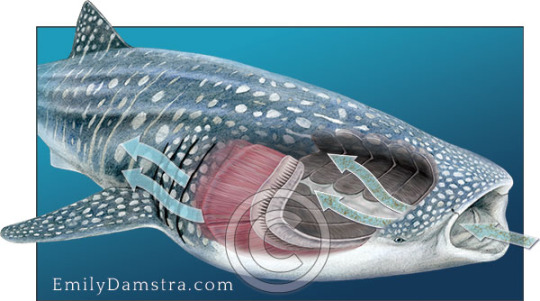
(Image: an artistic diagram of the feeding pads and gills of a whale shark and how water flows through the mouth and out the gills. Source: EmilyDamstra.com. End ID)
Whale sharks live in temperate and tropical oceans worldwide and can be found in both the open ocean and coastal regions. They are gentle giants who swim slowly and bask at the surface of the ocean, not threatening anything bigger than a sardine. While they spend a lot of time at the surface, whale sharks periodically dive in search of food. Most of these dives are less than 200 meters (660 ft) deep, but they will occasionally dive over 500 m (1,600 ft) deep. The deepest recorded dive reached 1,928 m (6,325 ft), the deepest recorded dive of any fish. Whale sharks are known to practice different feeding behavior based on available food in their region. There are two subpopulations of whale shark based on location: the Atlantic and Indo-Pacific populations. 75% of the whale shark population lives in the Indo-Pacific. Whale sharks seasonally migrate following warm waters and food and may also migrate to mate. Multiple places around the world host seasonal gatherings of whale shark, making them to best place to reliably see them.

(Image: a whale shark from the side, swimming with its mouth open. Other fish can be seen in the background. End ID)
Not much is known about Whale shark mating. It has only been seen a few times in Saint Helena Island in the Atlantic and off the coast of Australia. Mating likely occurs during the seasonal aggregations. Female whale sharks are believed to travel to regional pupping grounds to give birth, but where exactly these are is an open question as juvenile whale sharks are rarely seen. The youngest whale shark ever observed was discovered having been captured and tied to a stake on a beach in Pilar, the Philippines. It was measured at 38 cm (15 in) and was released after being measured. This discovery likely means there is a pupping ground in the area. Whale sharks are ovoviviparous, meaning their eggs hatch internally and the young are born live. Whale shark females are believed to be able to reserve sperm and impregnate themselves repeatedly between matings, rather than bearing all their young at once. It is not clear how long it takes whale sharks to mature or how long they can live, though some estimates put them at sexually mature at around 25 years old and with a maximum lifespan between 50 and 150 years. It is estimated that only 10% of whale sharks live long enough to reach sexual maturity. Adult whale sharks have no natural predators.

(Image: a baby whale shark that was rescued from a gill net in India. It looks like a smaller version of the adult, but with a proportionately larger head. A human (out of frame) is holding it just above the water. ENd ID)
Whale sharks are classified as endangered by the IUCN. They are threatened by fishing, poaching, bycatch, and boat strikes. Whale sharks are hunted for their skin, liver oil, and meat, though countries worldwide are increasingly regulating or banning whale shark hunting. Whale sharks also ingest large quantities of microplastics. The health effects of this are not understood currently. Whale sharks are kept in captivity in less than 20 aquariums worldwide. They need very large tanks and have special feeding requirements that makes it difficult to keep them healthy. Wild whale sharks pose no threat to humans though there have been reports of them ramming sport fishing boats after being provoked. In places where whale sharks seasonally aggregate, snorkeling or SCUBA diving alongside them has become a major ecotourism industry. Touching the sharks can hurt them and is illegal in most places. Some tourism agencies have been known to lure in young whale sharks by feeding them shrimp, something which is discouraged by naturalists as it can foster dependence on humans and potentially introduce dangerous chemicals to the sharks' diets.
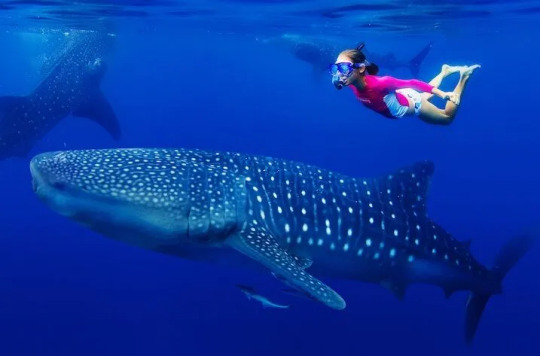
(Image: a person in a pink swimsuit wearing goggles and a snorkel swimming next to a whale shark just beneath the surface of the water. Two other whale sharks are in the background. End ID)
#wet beast wednesday#whale shark#shark#sharks#shark week#fish#fishblr#fishposting#carpet shark#marine biology#marine life#biology#ecology#zoology#animal facts#informative#educational#image described
162 notes
·
View notes
Text
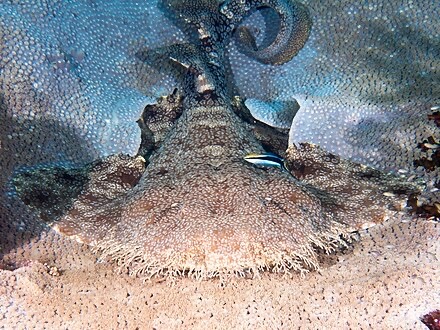
this odd little goober^^ is called a tasselled wobbegong and is 1 of 12 species of carpet shark in the orectolobidae family (wobbegong being the common name). orectolobidae are found in shallow, temperate and tropical waters of the western pacific ocean and eastern indian ocean, mainly around australia and indonesia. however, one, the japanese wobbegong, strays from this pattern by going as far as japan!
the 12 types of wobbegong are: tasselled, floral banded, gulf/banded, western, japanese, indonesian, spotted, ornate, dwarf spotted, network, northern and the cobbler wobbegong.
the reason for their classification as "carpet sharks" is of course related to their resemblance of ornately patterned carpets but also because they all have 5 gill slits, two spineless dorsal fins and a small mouth that doesn't extend past the eyes, as most of the species have barbels- small whiskerlike organs near the mouth which house taste buds and search for food in murky waters.
the tasselled wobbegong's arguably most distinctive trait is its fringe of branching dermal flaps around the head, which dribble onto its chin. the fringe enables the tasselled wobbegong to camouflage itself against the reef environment. this is done by the complex colour pattern of small blotches and reticulations (a pattern of interlacing lines resembling a net). their colour can actually change colour slowly over the course of several days to blend in with it's environment.
also, they're a nocturnal species and are only active at night. they're solitary snd spends most of the day resting in caves, under ledges, with their tail curled up around them. think of a really odd, kind of distorted and funny looking cat! similar, right? individual tasselled wobbegongs will have what's referred to as a small "home range". these areas contain several preferred resting spots which are used repeatedly.
wobbegongs primary diet is bottom-dwelling fish (mainly the bony type) and invertebrates such as small octopi, crabs or lobsters. when it hunts, they perch on reef and lunge up to suck in its prey. it then clamps down with its large jaw and fang-like teeth, not letting go until it's successfully killed its prey. the tasselled wobbegong is very opportunistic as it tends to remain in its favoured resting spot and whilst it's lounging, it'll ambush its prey. however, the little carpet also has its predators! this includes sharks- like the blacktip reef, horn, nurse, sand tiger and sand shark-, larger fishes and marine mammals.
these guys tend to reside in shallow habitats (ranging from 5 to 50 metres, 160 feet) near coral reefs! they're found in the tropical waters of the indo pacific ocean off of indonesia, australia and new guinea.
the maximum size of this species has been found to be 1 metre (4 feet) and it's complete lifespan is actually unknown but estimated to be about 26 years, between the average shark lifespan. this species has a very broad and flattened body and head, hence the carpet nickname.
we don't actually know much about the biological structure of the tasselled wobbegong but it's assumed to be a viviparous species (give birth to live young) based off of the reproductive habits of similar and related species. the pups are kept inside the womb of the female wobbegong in the form of eggs until they hatch and the young get their nourishment from the egg yolk. in a litter, there's typically 20 or more pups at a time. all measuring to about 20cm long (8 inches). their size at sexual maturity, however, is uncertain. their mating has been reported to have been observed in a cave at night, but not much else is known. one male, adult, was found to be adult at 1 metre - the average tasselled wobbegong size.
compared to other wobbegongs, the tasselled wobbegong is notorious for its "unprovoked attacks" on humans. whilst the species has certainly proved that it's capable of inflicting severe wounds, divers have also been able to approach the species without incident. given the sharks camouflaged appearance and poor vision, it's recommended people avoid accidentally harassing the shark as it will mistake a foot or hand as prey.
this carpet shark doesn't actually have a great economic value. although it's peculiar skin may occasionally be used for leather, it's not fished in australian waters and faces minimal threats. however, elsewhere, it may very well be affected by excessive fishery activity and habitat degradation (loss) from pollution, blast fishing (an illegal method involving explosives to stun/kill schools of fish) and coral removal. regarding this, the ICUN has declared this species of shark as least concern. meaning that it's still plentiful in the wild and isn't considered threatened or,pre 2001, conservation dependant.
note: ive came to the realisation that the previous image shown was a monkfish, not a tasseled wobbegong. i apologise for the misinformation! ive changed/updated the image since! very sorry
#shark#facts#fun facts#i love sharks#tasselled wobbegong#marine biology#marine life#ocean#special interest#science#biology#sea creatures#sea life#love to sea it#oceanposting#sharkblr#sharks
143 notes
·
View notes
Text
THE HIGHLAND KHAIT: AN OVERVIEW
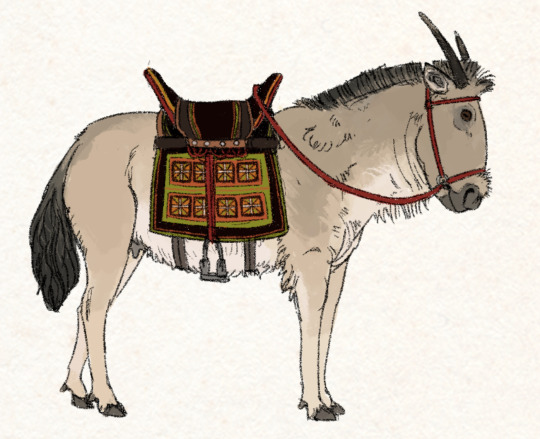
The Highland khait, known internally as the feydhi, is a landrace breed of the Highlands of contemporary Imperial Wardin, and highly distinctive from all other native khait in the region. Their horns are notably unusual, being curved and pointed and frequently asymmetrical, which is often cited as a result of their folkloric origins as hybrids of khait and the (asymmetrically one-antlered) scimitar deer. They are very stocky and small for a riding breed, typically standing no more (and usually less) than 55 inches at the shoulder. Their coats come in a wide variety of colors and patterning, though a majority of individuals are dun or gray. Their manes are notably short and stiff, and they lack the beards common in many other khait breeds.
While notably slower than other khait, feydhi are very surefooted and have notably smooth gaits, able to move at a steady trot over difficult terrain with minimal bouncing for the rider. They are extremely strong for their size, and fully capable of carrying most adult riders and heavy packs, and pulling plows.
Their hair is longer than average but provides little insulation and they do not grow winter coats, and instead rely predominantly on fat stores to cope with winter conditions. They are easy keepers that can gain and maintain mass with very poor grazing, though most require supplements of grain to their diets to gain sufficient fat stores to survive winters in the highest settled altitudes.
Feydhi can adapt well to the hotter lowlands conditions than other Highlands livestock largely due to this lack of thick hair. Because they require no supplement to their diet to maintain condition, they are very affordable khait and an asset (along with a few other specialized lowlands breeds) during dry seasons, and see wide use throughout Imperial Wardin (particularly as pack animals along trade routes). They often survive a little too well in the lowlands, being adapted to sparse mountain pastures rather than seasonally abundant grasslands, and can be prone to obesity when allowed to graze freely.
They show a small degree of selection for milk production due to the import of dairy to the regional diet of the Highlands. Their milk has the highest fat content of the native livestock, but a notably gamey taste that is generally disfavored. It's used primarily as-is for basic sustenance and medicinal purposes- growing children and pregnant women are encouraged to drink feydhi milk to build fat stores, and mounted herders will often ride lactating mares in the winter and subsist largely upon their milk. Their meat is also the fattiest of any of the regional livestock and (unlike their milk) generally regarded as the best in taste, though their value as riding animals and more expensive upkeep prevents their consumption on any regular basis.
Rendered, chilled feydhi fat mashed with berries and eaten on bread is a seasonal delicacy eaten at midwinter feasts. It is considered an obligation of a wealthy ruling clan to slaughter some of their khait and provide the fat for this meal to their dependents, and an indication of failing wealth and authority if they cannot. A phrase translating as 'rich in cattle, poor in fat' invokes the notion of having a clan having superficial wealth (in cattle, which can largely sustain themselves on poor grazing and thus can hide a loss of material power for a period) but a heavily insecure position (unable to actually afford to lose their more high maintenance assets), and is used colloquially to describe a person or people giving hollow performances to mask lacking or lost substance.
They have some unique behavioral quirks among khait, such as a propensity to use their lower teeth in allogrooming to rake and scratch each other. This favoring of their teeth also lends more aggressive animals to biting (in addition to the far more khait-typical headbutting and kicking), a behavior that seems reserved exclusively for humans and is rarely used in intraspecies conflict. As with all bovidae, they no upper incisors and their bite can only do so much harm in most circumstances, but they can cause significant damage to the fingers of the unwary. They are also known for their tendency to consume bite-sized animals such as small birds when given the opportunity- this is not atypical of khait (or many grazing herbivores at large), but is emphasized in combination with their tendency to bite to cast them as uniquely carnivorous.
Their temperaments are regarded as notably stubborn and somewhat testy, but this is made up for with their intelligence and generally calm demeanor. Feydhi are most prized for their bravery- they do not spook easily against wild predators and can perform some functions as livestock guardians, readily chasing off small threats and known to stand their ground against even large predators, particularly hyena (the most populous and routinely threatening predator in the region).
This trait is commonly noted in folktales- one western mountain pass is said to be haunted by the ghost of an old gray mare who stood guard over her master (a noted drunk, who had fallen off her back and passed out) against a pack of hyenas for an entire night. When her rider awoke the next day, he found her dead and bloodied with her horns stuck into a hyena's side, having killed the predators but succumbed to her own wounds. He was so sorrowful that he resolved to never drink again (outside of holidays, and perhaps weddings) and buried her under stone. Travelers through this pass customarily pour out liquor and leave little offerings of grain for the animal's spirit, which is said to be seen at night from a distance, standing vigilant atop its cairn, but vanishes when approached.
The settlement cycle stories of the Hill Tribes go into extensive detail about the cattle and horses brought overseas with the migrants, but elaborate little on their khait and imply that a riding culture did not exist during the settlement period. The stories tend to describe people as walking on foot or riding their cattle, and khait riding is only mentioned in descriptions of proto-Wardi mounted nomads in the lowlands. It is likely that khait riding (rather than sole use as pack animals) was an adopted practice post-settlement, and possible that khait were not brought along with the migrants to begin with.
The actual origins of the feydhi breed are ambiguous as such. Old Ephenni folklore mentions tiny 'fairy' khait living in the Highlands that predated the arrival of the Hill Tribes, suggesting that these animals were already established as feral herds. It's highly possible that these herds were are a relic of the cairn-building civilization that existed in the Highlands prior to recorded history and had already long vanished (likely in a combination of plague and dispersal) prior to the settlement. The stories of feydhi being hybrids between foreign khait and native deer is also suggestive of such an origin, with wild deer as ancestors being a mythologized twist on feral khait.
Feydhi do not have the same status of cattle or horses as fundamental to subsistence, with much of their use being in utility as pack animals and transport over difficult terrain. However, they play very significant roles in the livestock raiding aspects of warrior culture, where they are used for quick exits and to help drive cattle and horses. Their roles in other aspects of warrior culture are more varied between tribes- some use them near-exclusively for raids, while others rely on them for open combat. Khait warrior culture is most central in the western Urbinnas tribes, who each consider themselves to be the most skilled riders and uniquely specialize towards mounted archery. The Urbinnas tribes have a long history of interaction with the lowlands Ephenni Wardi (alternating cycles of conflict and trade, and a half century of allyship against Imperial Burri occupiers). Both groups have a strong history of mounted warrior culture, and each claims to have introduced mounted archery to the other.
Khait also play roles in regional combat sports, which include mock battles and raids, races, archery, and most famously khait wrestling. The latter involves two mounted riders attempting to wrestle one another off their khait, gain control of their opponent's mount, and then successfully lead both animals out of the ring without their opponent re-mounting. This sport requires very calm, collected animals that will not panic while being fought over, and the measured temperament of the feydhi is well suited.
#The Wardi Highlands are not analogous to Iceland At All but having just spent a week surrounded by an awesome small cold#adapted horse landrace breed it was time to like actually flesh these guys out#creatures#hill tribes
140 notes
·
View notes
Text

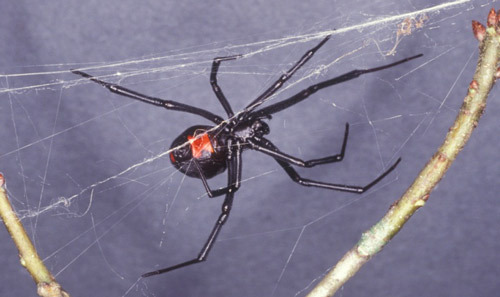

No Tears for the Southern Black Widow
Latrodectus mactans, more commonly known as the southern black widow, is the most common species in the black widow family. While it can be found throughout North America, they are found most often in the southern United States. Within this wide range, L. mactans enjoys a variety of habitats. They prefer areas that are close to the ground, dark, and sheltered; in the wild this may mean dense brush or under logs, while in inhabited areas they may be found in basements, log piles, or under trash lids.
In addition to being the most common black widow, L. mactans is also the largest member of the family Theridiidae. The females are larger than the males, averaging at about 8-10 mm (0.31- 0.39 in) in length and weighing about 1 g (0.04 oz); however the male's legs are generally longer than the females. Both males and females are black, with small thoraxes and extremely large, round abdomens. The female can be distinguished by the iconic red hour-glass shape on the underside of her abdomen, while the male has 4 pairs of red and white stripes on each side of his abdomen.
The southern black widow is mainly solitary, spending most of its time in or near its web. Only the females live long enough to build a web for catching prey, and are the sole source of black widow bites. While bites do require medical attention, no human fatalities have been reported since 1983.
During the day, females hang in the center of the web to expose the bright red warning on their abdomen; when startled they drop to the ground and play dead. Though the webs they construct are haphazard-- the stereotype of cobwebs-- they are extremely strong and are capable of catching woodlice, millipedes, centipedes, other spiders, and occasionally small mice. Once an animal becomes trapped in L. mactan's web, the spider envenoms its prey and wraps it in a thick cocoon. After the animal dies the spider injects it with digestive enzymes and consumes the resulting fluid. Despite their strong venom, the southern black widow can be victim to several predaotrs; namely wasps, the brown widow spider, praying mantises, and large centipedes.
The southern black widow mates primarily in the spring and summer. Mature males build small webs and deposit semen along the threads. He then coats his mouthpieces-- palps-- with sperm and sets out to find a female mate. To court her, he vibrates the threads of her web until she is receptive. On rare occasions, a displeased female may eat the male. Afterwards, if he survives, the male leaves the females web and dies soon afterwards. From just one encounter, the female can store enough sperm to last her a lifetime of reproductive cycles.
After fertilization, the female builds a small web where she lays her egg sac, which can contain up to 400 eggs. She guards these eggs until they hatch about 20 days later, and immedietly disperse to establish their own territories. Until they become fully mature, at about 90 days old, juveniles have no venom and are extremely vulnerable to predators- including adult black widows. Typically only about 30 individuals from a single clutch survive to adulthood. Once mature, males can live for only one year, while females can live up to three years in the wild.
Conservation status: The IUCN has not evaluated the southern black widow, but due to its large range and population size it is considered stable. It is able to adapt to most habitats, and thus the species' only threat comes from extermination via pest control.
If you send me proof that you’ve made a donation to UNRWA or another organization benefiting Palestinians, I’ll make art of any animal of your choosing.
Photos
Mark Kostich
James L. Castner
Meghan F. Murphy
#southern black widow#Araneae#Theridiidae#black widows#true widows#tangle-web spiders#cobweb spiders#spiders#arachnids#arthropods#generalist fauna#generalist arthropods#urban fauna#urban arthropods#north america#southern north america
174 notes
·
View notes
Note
I had never thought about the fact that snakes would have more than the set of initial fangs so that post you did on snake bites is fascinating!! Thank you so much for all the information you give us, it is very much appreciated how much time and effort you put in to helping people learn about snakes!!
I have a couple questions for you regarding snakes teeth!
1. Do all snakes have the same amount of teeth once they've reached adult hood or do different breeds have different amounts for their specific needs?
2. Do snakes have and lose their "baby" teeth and grow in adult ones like other animals and humans? Or do they grow with the snake as they age?
3. I work in the veterinary industry with dogs and cats and your post also made me think about if snakes would need dental care like dogs and cats do, like would you ever have to have a snake have a tooth pulled if there was an issue with it? Made me picture a little snake under anesthesia with its little tongue hanging out while getting it's teeth cleaned like I see with dogs and cats and it made me laugh!
Sorry if these are silly questions, again thank you so so much for all your hard work 🩷🩷
Great questions!!
First thing, before I get into your specific questions: not all snakes have fangs! There are exceptions, but snakes generally fall into four dentition categories.
Aglyphous dentition is when snakes don't have fangs at all. Teeth are generally the same size and shape. All nonvenomous snakes, like boas and pythons, fall into this category! These snakes tend to have a lot of teeth (hundreds!) and they can be in a single row or multiple rows.
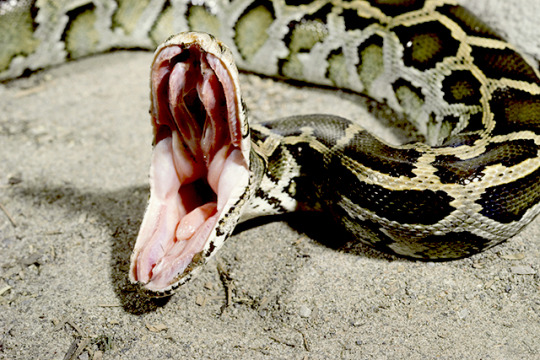
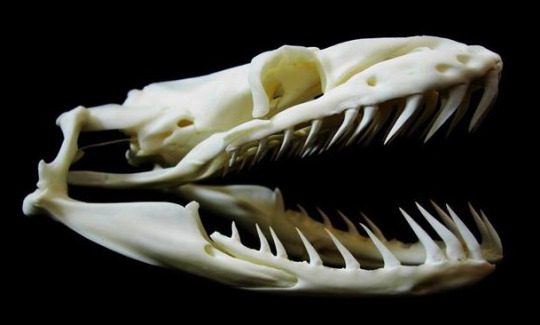
Then there's solenoglyphous dentition, which is what people generally think of when we talk about snake teeth. There's comparatively very few teeth and two large, hinged fangs that fold up against the roof of the mouth. Vipers are solenoglyphs.


Next, there's proteroglyphous dentition, which looks similar to solenoglyphous dentition except the fangs are much smaller and always in place. Elapids (cobras and their relatives) have this type.


The last major type of snake dentition is opisthoglyphous dentition, which are our rear-fanged venomous colubrids. These snakes have large fangs at the back of their mouths; it's kinda a garbage fang system but they're doing their best. Hognoses, boomslangs, and most other venomous colubrids are here.


Okay, now that we've got the basics out of the way...
Baby snakes are born with the same number as adults, but as I'm sure you've already guessed from the pictures above, the number varies wildly by species! Snakes average around 50-100 teeth across species, with the number skewing upwards thanks to nonvenomous snakes, but vipers and elapids typically have less than fifty.
Snakes don't have baby teeth! Teeth fall out and are replaced throughout their lives.
Snakes generally don't need dental care (although that image is super cute!). However, teeth can totally cause problems. The most common ones I see are stuck teeth - because snake jaws are so flexible, sometimes they accidentally get a tooth stuck in their gums. That can usually be fixed by simply gently guiding the snake's mouth open, but sometimes stuck teeth do require professional help. Even at its most complicated, dental care for snakes usually just involves a round of antibiotics in the case of infections - problem teeth often fall out on their own or are easily pulled with the help of local pain relief.
176 notes
·
View notes
Text
the Xa
I wasn't planning on revealing another sophont, but it's a creature I have a decent amount of information and sketches on, so I decided to post it while I work on some complex 3D art for this world. The Xa are tall black birds you may have seen in the Intro to Total Convergence..?.

These two meter tall avians use their wings for walking. Their thumb has increased in size and the claw has re-appeared and modified into a hoof. They primarily use their beaks for manipulating with objects, but their feet, which the Xa leave off the ground when walking, greatly assist with this. Another ancient feature that has re-appeared in this bird are the teeth, but they aren't used for eating. The teeth of the Xa have bright golden and dark red stripes and are flattened, resembling our incisors, and are used as a dispaly structures during communication.
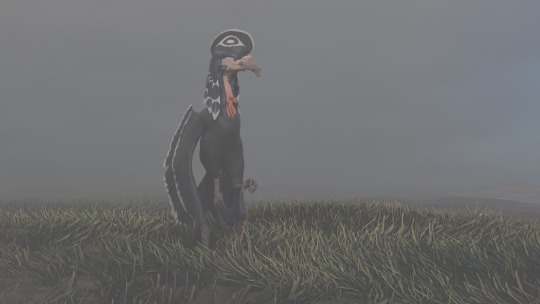
Normally, a Xa would walk around with their head resting on the neck, their beak covered up by their thick plumage. This one got startled by a distant noise and is looking around.


I'm still deciding whether to keep the "lip pads" or not.
A Xa's perception of reality and the rate at which they take in information is also remarkably fast. An average Xa, for example, is able to read one A4 page full of text in circa five seconds. This means that a Xa can graduate way faster than a human, making up for their short lifespan. This is one of the reasons why it can be hard for them to enjoy movies, the ones that were made by non Xa are unwatchable because of the "low frame rate".
There is almost no sexual dimorphism in these birds. On normal occasions the gender nor sex of a Xa is not distinguished at all, and probably no Xaian cultures have different social roles for men and women. The only way to tell the sexes apart is through pheromones, which are only released on special occasions. Only Xa are sensitive to these pheromones, and non avians wouldn't be able to tell the difference at all.
The Xa are relatively short lived, maturing at the age of seven. In the prehistory, they could live up to be twenty years old, but thanks to modern medicine, their lifespan has increased to be up to thirty years. When hatched, a baby Xa is born featherless, growing a coat of ash-brown downy feathers after ten months. A "pre-teen" coat - black contour feathers - begins to appear at the age of four, and at the age of seven, the "adult" plumage with its characteristic white eye pattern and contrasting, irridescent black feathers on the Xa's crest appears. These white patterns typically fade to gray with old age. The irridescence is also a lot less striking in older Xa.
Due to their plumage, they don't really need soft fabric to make their clothes comfortable, they mostly focus on making waterproof and elegant garments. But soft fabric can sometimes be a sign of the wearer's status. Because of their reliability on their beak as our equivalent of hands, the great majority of utensils and tools are made to be carried in and controlled by the beak. Tools and guns specificaly are mostly attachment based - there are several types of universal helmets that are used to attach a variety of tools to them. A lot of guns can be operated with both beak and hands. Shooting a gun is a lot easier when a Xa uses their beak, but hands are more practical when they need to quickly draw the weapon.
More on their evolution later!
#artists on tumblr#creature design#speculative evolution#worldbuilding#digital art#spec bio#spec evo#speculative fiction#3d#3d art#3d render#3d model#blender#art#bird art#creature#artwork#speculative biology
104 notes
·
View notes
Text

As marsupials, Selkie have a very different growth pattern from mammals. Called 'pups', selkie infants do not gain a name until they are able to ambulate, however clumsily, outside of the male's pouch. They take significantly less time to mature as compared to human children through their development.
A. A selkie egg. Usually laid in a clutch of 1-3, an average of 2 eggs survive incubation in the pouch. Eggs are held in the male selkie's pouch and regularly checked on with the egg remains removed once the pup has hatched. All eggs are uniform in color, only being distinguished by the male's scent which rubs off on them.
B. 0-1 years. The pup must spend all of its time in the male's pouch or risk illness and/or hypothermia since they cannot thermoregulate at this point in development. All of their limbs and tail are undeveloped with only the mouth developed enough to lap from the milk patches inside the male's pouch. Pups sometimes trample their siblings in the pouch but usually both pups will survive if the male is in good health.
C. 2-5 years. Finally able to emerge from the pouch, pups at this age begin to acquire language and mobility. Pups gain their name, becoming 'people' instead of a nameless baby. Pups typically begin speaking with their mouth but learn to utilize their melon for speech as they age; speaking with the mouth is viewed as juveniles or cutsey in selkie culture as a result.
D. 5-9 years. Bulking up, a pup is now fully furred and can learn to swim At this age, selkie pups can finally safely play with humans of a similar age as pups younger then this play very roughly. In Antartica, selkie at this age will begin to learn skills from their parents or talented adults if they are pursuing a particular occupation. Outside Antartica, most selkie will begin attending school.
E. 9-12 years. An adolescent selkie. Hitting puberty, selkie typically experience the usual moodiness and rebelliousness as human teenagers. Usually gangly and misproportioned as they grow, selkie of this age will cover their body more than any other age range to cope with body dysphoria.
F. 13-17 years. A young adult selkie. At this age, selkie are nearly done growing. Females and faeders may have a secondary growth spurt at this stage but otherwise most growth is packing on pounds to stay warm in the polar climate. Selkie who have been apprentices will generally be accepted to informal guilds and solidify their occupation. Unless the selkie is particularly lithe, most lose the ability to leap more than a few inches into the air like their marsupial ancestors.
G. 17-20 years. A fully grown selkie. Barring any hormonal issues, a selkie won't grow in size past this point. Considered to legally be an 'adult' by the age of 17, selkie can start a family, manage their affairs, and leave their family's home.
#species: selkie#world: walking whale#speculative biology#spec evo#spec biology#spec bio#worldbuilding
33 notes
·
View notes
Text

An introduction to Castor erectus:
Castor erectus, common name "Mountain Dwarf" is member of Castorimorphia, a suborder of rodents that consists of the superfamilies Castoroidea, (Modern Beavers) and Geomyoidea (Kangaroo Rats). In our current timeline, the genus Castor has only two extant members, Castor canadensis, common name "North American Beaver", and Castor fiber, common name "Eurasian Beaver". Castor erectus offers an alternate evolutionary history where Beavers evolved to fill human-like niches. Their look and culture are heavily inspired by the stories of Dwarves as told in fantasy epics such as Lord of the Rings, as well as stories of dwarves from Germanic folklore. Their design is meant to be unique enough to offer an interesting history and flavor for Dwarves, while still being familiar enough to be recognizable as Dwarves. Castor erectus stands at an average of 4'5", with specimens varying in height by +/- 4 inches (for healthy adults.) Female dwarves are on average 3 inches shorter than their male counterparts. Castor erectus shows little to no sexual dimorphism. (You may have seen my previous sexual dimorphism model, this was based on my incorrect assumption that strong sexual dimorphism was present across most mammals.) Modern beavers lack external genitalia, a trait that is present in Castor erectus, which makes it difficult to distinguish a Dwarf's sex. Members of the species can easily distinguish the sex of other members through smell, though their culture does not place a heavy emphasis on gender. The Dwarven language lacks gendered pronouns, and sexuality among Dwarves is incredibly fluid. Same sex pairings can be a helpful evolutionary tool, allowing communal-living social species to meet the social and sexual needs of its' members, without increasing population of their colony to an unsustainable size. Dwarves typically live in large colonies constructed in and around mountain cave systems. These structures are known as Lodges, which are an evolved form of modern beaver habitats. The construction of these lodges generally begins with the construction of a large cistern, and a canal below the snowcap of their home mountain which diverts runoff into the cistern for collection. They use this collected water to fuel primitive aquaponics and hydroponics systems in their lodges. Dwarves are often separated into small familial groups, but it is not uncommon for distantly related groups to merge into a single colony to control resources and water. In the future, I will be posting more illustrations and writings detailing Dwarven Culture, as well as exploring their evolutionary history through extinct relatives. If you have any questions about their culture or anatomy in the mean time, feel free to ask! Any amount of feedback helps to flesh them out and answer questions I might not have otherwise thought of.
#dwarves#dwarf#speculative anatomy#speculative zoology#speculative biology#spec bio#specbio#fantasy art#evolution#anatomy#digital art
42 notes
·
View notes
Text

@stormandsparks ok
i did some maths. proof is under the cut
frogzilla is a Leptodactylus fallax, commonly known as the mountain chicken or giant ditch frog, which is native to the caribbean islands and is critically endangered. (www.amphibiaweb.org)
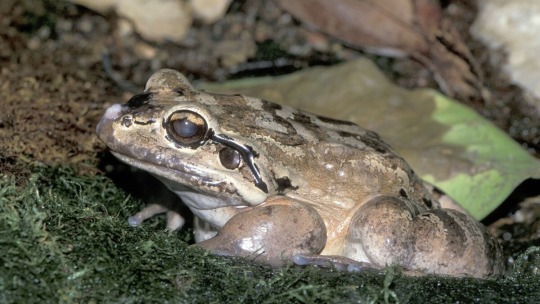
total skin thickness: 397.81µm ± 12.07µm (0.39781mm) (from The Anatomical Record, Vol. 300, Issue 10)
typical adult size: 17-18cm (snout to vent) (from wikipedia)
enterprise size: 288.6m (length) (from cygnus-x1 blueprints)
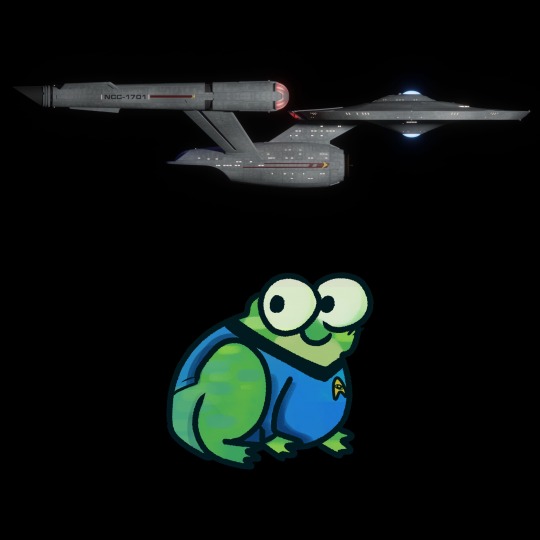
if we use this image for scale.

using my ruler, the enterprise is 6.1cm long and frogzilla is 2.5cm snout to vent
6.1cm -> 288.6m
28860/6.1 = 4731.1475 (4d.p)
4731.1475 is our multiplying factor
2.5cm x 4731.1475= 11827.8688cm (4d.p)
length of frogzilla = 118.278688m
so taking this size and the average size of the mountain chicken from before (17.5cm)
11827.8688/17.5=675.878217 (6d.p)
this is our new multiplying factor
so to work out the thickness of frogzilla's skin:
0.39781mm x 675.878217 = 26.887111350477cm ≈ 26.9cm
so if we assume a hypospray takes one second to work for human skin which has an average thickness of around 1.3mm, it would take 206.82393346521 seconds, or about 3.44 minutes for christine chapel's hypospray to work on frogzilla. in which time he would've sat on her.
(obviously i've rounded down a lot of these numbers and taken averages so there's a margin of error which i am absolutely not going to work out 👍)
(edit: i converted mm to cm wrong but i've fixed it now 😔😩)
17 notes
·
View notes
Text
Monster Spotlight: Calpina

CR 3
Chaotic Neutral Small Fey
Bestiary 6, pg. 53
These nasty creatures represent a rare species of Fey that's fully parasitic, feeding off others in their every stage of existence in a grotesque combination of mosquitos and wasps. While a relatively harmless nuisance in the springtime, when the season turns to summer the Calpina enter a breeding frenzy during which they operate similar to colony insects, gathering in swarms of up to 24 individuals in a single nest and heading out in groups of 3 or more at a time (ominously referred to as eclipses) to find food to bring back to the nest for their young.
"Food" in this case being just about any living creature they can find. Calpina aren't picky when choosing their meals, but their curiosity and interest in what the more civilized folk are doing typically means they haunt the edges of civilizations, especially small towns and farmlands where they have access to delicious, nutritious humans, their best source of food for numerous reasons. Adult Calpina feed on personality, their dangerous Ego Drain caused by them slipping their long, spiny tongues into a victim's soul and slurping up portions of their self, causing an automatic and unavoidable 1d4 Charisma damage at the end of the Fey's turn if it's managed to grapple a target.
Their sole means of offense is a pathetically weak bite, dealing only 1d4 damage, but this is because the bite isn't meant to be a weapon, but a means to an end; the bite can Grab targets up to Medium size without penalty, easily establishing the hold they require to feed. The average Calpina requires at least 14 points of Charisma to feel full for a complete 24 hours (a full Calpina can no longer use Ego Drain) and will feed indiscriminately until this threshold is met, be it on animals, people, and even other Fey if they can get away with it, though they obviously prefer the likes of humans and elves; the average person has 10 Cha, enough for almost a full meal on its own! Normal Calpina don't bother conversing with creatures they view as food, but they ARE intelligent and they DO speak Common, sometimes allowing them to use Bluff to secure food from a group of people... or even just simply asking, since 3 points taken from five people is much easier for the crowd to withstand. Calpina that are kind enough to ask are few and far between, though, and one should be incredibly suspicious of such creatures, especially during summer and autumn.
During these seasons, any creature drank to 0 Charisma or otherwise rendered unconscious is brought back to the Calpina's nest, though the Fey will also use Bluff, pixie antics, or their Perform (Dance) to lure creatures in close for their sisters to ambush to obtain the same result. Groups of Calpina are dangerous not only because of their combined Ego Drain rapidly knocking foes out, but because each one can attempt to use its Fragrant Haze to take the fight out of a group of foes. This burst of magical vapor causes exhaustion in non-Calpina creatures within 20ft who fail a DC 14 Will save, reducing the victims' Str and Dex by -6 for 1d4 rounds and often meaning the common villager (and low-level adventurer) can't pierce their DR 5 without a cold iron weapon, preventing them from fighting back until they're completely drained and rendered unconscious.
Such victims are fed whole and alive to the Calpina's carnivorous larvae, kept comatose by Charisma damage as grubs the size of a man's hand devour pounds of meat from the victims the course of the next few weeks before they finally pupate into fully-grown Calpina to join their sisters and parents in their hunts. A friendly (if disquieting) Calpina met in the winter or spring may turn into a merciless predator when breeding season rolls around, drinking their fill from people who once saw them as pesky neighbors before disappearing them into the woods to be sacrificed to the next generation.
You can read more about them here.
16 notes
·
View notes
Text
Wet Beast Wednesday: Nile crocodile
Humans in general often have a fear of large reptiles. This may have an evolutionary advantage as it helped our smaller ancestors avoid large predators like snakes and crocodiles. Whatever the reason, the fear has entered into many belief systems and one common feature in many myths, legends, and religions of Africa and the Middle East is the Nile crocodile. While their reputation as man-eaters is somewhat exaggerated, Nile crocs are one of the most dangerous reptiles to humans, with only the saltwater crocodile matching them in human deaths. However, like most animals, the danger can be avoided if you know what to do and what not to do.
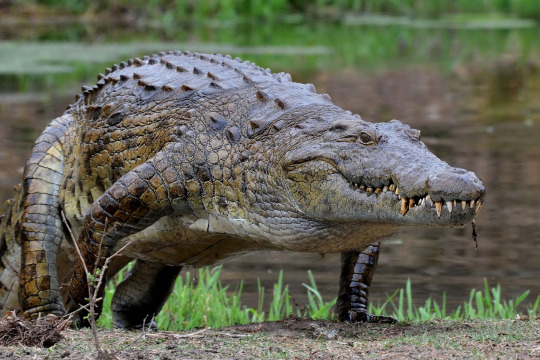
(Image ID: a Nile crocodile walking on land, seen from the front. It is a quadruped with short limbs on the side of its body, scaly skin, and an elongated set of jaws with protruding teeth. The tail is out of view. Its body is dark brown on top and yellowish on the sides. End ID)
The Nile crocodile, Crocodylus niloticus, is the second largest crocodilian and (depending on how you measure some snakes) possibly the second largest living reptile after the saltwater crocodile. Average adult males (which are larger than females) reach between 3.5 and 5 meters (11.5 to 16.5 ft) and and 255 to 270 kg (500 to 1,650 lbs), but some specimens have gotten considerably larger, with the largest confirmed size on record being a male who broke the scale at 6.45 m (21 ft) and between 1,043 and 1,089 kg (2,300 - 2,400 lbs). Nile crocodiles are fairly typical crocodilians. They are large quadrupeds with scaly skin covered with scutes and osteoderms, long and powerful jaws, and eyes, ears, and nostrils on top of their heads. Their eyes are protected with transparent eyelids called nictitating membranes and their skin has many sense organs whose purpose is poorly understood but may help detect changes in water pressure. While on land, the crocodiles are fairly slow and ungainly, but they can swim at high speeds when needed. The broad jaws and powerful muscles give the crocodiles an enormous bite force, being able to bite down on prey with 22 kilonewtons of force. For comparison, humans max out at about 0.7 kilonewtons. This force can also be continuously applies for long periods of time, allowing the crocodiles to hold struggling prey in their mouth and drag it underwater. Famously, though crocodilians can close their jaws with incredible force, the muscles for opening their jaws are much weaker and can be held shut with a person's bare hands or some duct tape. They have dark bronze scales on the back and lighter yellow scales on the sides and underbelly, marked with dark spots. The color darkens as the animal ages. As with all crocodilians, the Nile crocodile has a four-chambered heart that is highly efficient at oxygenating blood and is similar to the hearts of birds. Crocodilians and birds are actually more closely related to each other than they are to anything else still alive. All crocodilians have high lactic acid levels in their blood. This allows them to sit motionless for long periods of time, but increased levels due to overexertion can kill them.

(Image ID: a Nile crocodile resting in the water just offshore, with most of its body still visible. This one is a lighter brown. Its tail is visible. It is long and thick, with two rows of scutes running down it. Its mouth is open. End ID)
Nile crocodiles are found throughout a large portion of Africa and are the most widespread crocodiles, with only the saltwater crocodile having a wider distribution. Their current range is smaller than it used to be and now it is known that areas there were once thought to be part of the Nile croc's range are actually home to the similar species known as the West African crocodile. The West African crocodile was formerly believed to be the same species as the Nile crocodile and was only reclassified in 2011. Their habitat is freshwater lakes, waterways, and swamps throughout Africa. They can tolerate brackish or marine water, but but prefer fresh water. Like other crocodilians, Nile crocs are largely sedentary ambush predators. They can remain motionless for long periods of time, often submerged with only their eyes, ears, and nostrils exposed. A crocodile submerged like this can easily be mistaken for a log. When prey comes close, the crocodile will lunge forward and bite down. Larger prey that is not killed outright will be dragged into the water and drowned. Almost uniquely among crocodilians, nile crocodiles are known to hunt on land. They still employ ambush tactics, usually hiding in brush along paths at night and attacking animals passing by. They have even been known to try to steal kills from land predators and get into tug-of-war battles with lions over pieces of carrion. While clips of a massive crocodile leaping out of the water to drag a zebra to its doom make for entertaining documentaries, about 70% of a Nile crocodile's diet is composed of fish. As an individual grows, larger land animals will make up more of its diet. Nile crocs have been known to cooperate to herd fish into tight spots where they are easier to catch and eat. While famous for their skill and hunting and killing prey, Nile crocodiles are anything but voracious eaters. Their stomachs are pretty small for their size, only around the volume of a basketball. They can also go long periods of time between meals, sometimes several months without signs of starvation. Nile crocodiles are a classic case of apex predators. An adult Nile crocodile has no natural predators, though young ones do get attacked and eaten by larger predators, including other crocodiles. Curiously, they are known to swallow stones. Swallowing stones, known as gastroliths, it a well-known behavior in the animal kingdom. They are usually held in the digestive tract and used to help grind up tough food. Most species that use gastroliths are herbivores or omnivores who use them to help grind up tough plant matter, so it's not clear why the carnivorous crocodiles need gastroliths.

(Image ID: a nile crocodile's had visible above water. Its mouth is open and in it is a silvery fish known as a tilapia. End ID)
youtube
(Video ID: a clip from the BBC Earth showing a Nile crocodile successfully attacking a wildebeest. End ID)
When not attacking prey, Nile crocs are pretty sedentary. They can easily spend most of the day basking in the sun, behavior common to large reptiles who need a long time in the heat to warm their bodies enough to perform daily functions. While basking, they sit on land, often with their mouths open. The open mouths are vital for thermoregulation (a crocodile with its mouth sealed shut can overheat and die), but may also serve as a warning to others who may want to steal their spot. In the southernmost reach of their range, Nile crocodiles may wait out the cool, dry months of May to August by digging burrows and entering aestivation, a state similar to hibernation. Nile crocodiles are social creatures that live, bask, and hunt together. They follow a social order with the largest individual around (almost always an old male) being in charge and having first access to food and the best territory. Males are territorial and will try to force other males out of their range. Larger males will be able to maintain the best territories while smaller males are forced to live on the outskirts. Females are not territorial and will seek out the best male territories to live in. While territorial, crocs of all sizes will come together while basking and their interaction then are mostly peaceful. they are known to communicate through posturing, touch, and vocalizations. Males are known to compete over territory and while most of these competitions are settled through threat displays, they may escalate to violence.

(Image ID: four crocodiles resting on a sandy shoreline. End ID)
Territoriality is especially prominent during mating. The mating season begins around the beginning of the dry season and varies based on location. Males will signal for females with several noises, including bellowing, blowing water out of their noses, and slapping the water with their heads. Males will also attempt to drive other males away to reduce competition. When a female chooses a male, she will approach him and the pair rub their jaws together while making a warbling sound. Males like it rough, roaring and pining the females down, sometimes underwater, while mating. Most males will only mate with a single female each year, though some particularly successful males in certain regions will can multiple mates each year. After two months, the female lays her eggs. While most crocodilians incubate their eggs in piles of rotting leaves, Nile crocodiles use sandy banks or beaches. The female digs a nest, lays up to 80 eggs in it, then buries the eggs. The heat of the sun is used to incubate the eggs and to determine the sex of the offspring. Eggs incubated between 31.7 and 34.5 degrees C will be male. All others will be female. Nests used to be laid extremely close to each other, but but to increased disturbances along the nesting sites, this has become rare. During the incubation period, the mother guards the nest continuously, only leaving to avoid overheating by resting in the shade or entering the water. The father also plays a role, patrolling the area around the nest to drive away predators who would eat the eggs. Incubation lasts about 90 days and the female usually will not eat during this time. The hatchlings will make chirping noises before hatching to signal to the mother that she needs to dig out the nest. Once uncovered, the mother may use her jaws to crack the eggs and assist hatching. Hatchings start at around 280 mm (11 in) long and 70 grams (2.5 oz) and will increase by that rate for the first few years. The mother will protect her offspring for up to two years, often carrying them on her back or in her mouth or throat pouch to keep them safe from predators. The juveniles feed on insects for the first few years of life. Even after leaving their mother, hatchlings will often live in groups until they are large enough to not have to worry about predators. It is estimated that only 10% of eggs hatch and 1% of hatchlings survive to adulthood. Sexual maturity is reached at around 11 to 12 years and the maximum lifespan is estimated to be 70 to 100 years.
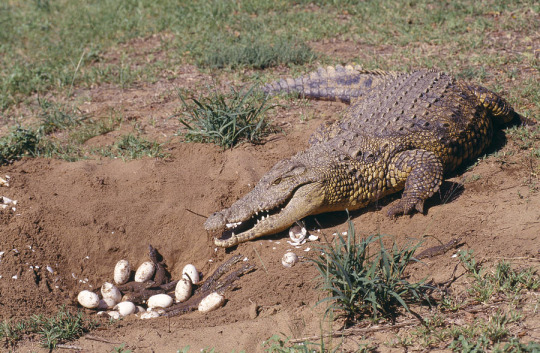
(Image ID: a Nile crocodile mother standing at the edge of her nest, a pit in the ground. Multiple white eggs are visible, as are newly-hatched crocodiles, which are far smaller version of an adult. End ID)
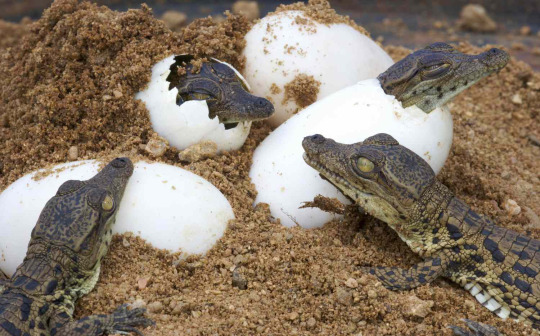
(Image ID: Nile crocodile eggs hatching. Four eggs are visible and two are actively hatching, with only the hatchling's heads having emerged. Two other crocodiles have already hatched. End ID)
Nile crocodiles are threatened by habitat loss, pollution, prey loss, bycatch, and human hunting. From the 1940s to the 60s, Nile crocodiles were hunted in massive numbers for the leather trade and were near extinction until new laws, international trade regulations, and conservation efforts largely stopped the hunting efforts. Despite this, their population has not returned to pre-hunting levels and they have been extirpated from many locations. Poaching still happens, as does hunting due to their perceived status as man-eaters, which is actively hindering conservation efforts. Like with sharks, the public image of an animal as being dangerous to humans directly harms its survivability and conservation efforts. Loss of habitat and suitable nesting sites due to damming and other human-caused changes to wetlands have also damaged crocodile populations. An invasive plant, Chromolaena odorata, is harming the crocodiles due to it growing out of control in nesting grounds. The shade from the plants keeps the sun from warming the eggs, causing them to die. Nile crocodiles and saltwater crocodiles are responsible fro the vast majority of attacks on humans and it is estimated that Nile crocs may be responsible for hundreds of deaths (most of them unreported) a year. Only the largest individuals pose a threat to adult humans, though children are at risk to smaller crocs. In fact, Nile crocodiles kill more humans per year through direct attacks than any other wild animal. Those numbers are still dwarfed by deaths due to disease spreading animals, animals acting in self-defense, or attacks or injuries from domesticated animals. For the most part, the crocodiles do not seem to target humans, the number of attacks comes from humans and the crocodiles both living near the water's edge and the crocodiles' nature as generalist predators of large animals. People who study and interact with the crocodiles report that if the right precautions are taken, the danger from being around the animals is negligible and many people and groups have tried to spread safety precautions, especially to poor and remote areas where attacks are likely the most common.

(Image ID: several juvenile Nile crocodiles in a tank being fed. Someone is using a grabber on a stick to drop meat into the tank. Four of the crocodiles are rearing out of the water to get the food. End ID)
#wet beast wednesday#nile crocodile#crocodile#crocodilian#africa#reptile#freshwater biology#freshwater ecology#biology#zoology#ecology#images#image described#cw mentions of death#animal attack#animal facts#Youtube
33 notes
·
View notes
Note
Hi! I’d like to start with the fact that your writing is PHENOMENAL, the way every first chapter is designed to grab the readers attention, with a mystery or a cozy little opening, establishing where the character is in life and their motives, or a sneak peek at the problem the characters must overcome.
I’m really bad at articulating my thoughts, but ur characters are really well written and I’d like to make more fanart of them, but I’m not quite sure what they look like.
(The only fics of your la that i KNOW you wrote are Unto Dust, and The Comfort of Agony (both of which are really good btw, I also love how you write existing characters, and your portrayal of them(especially Lucy Ann))
Anyway, because there are so many interpretations of species used in TAU, I got a little mixed up on what the non-human characters look like.
Darceus- in Lucy Ann and the Lunch Bunch, there is a Kitsune named Felicity, who is described as “looking a kind of like a human, and kind of like a fox” which my interpretation of is shown below. I forgot that that isn’t typical for kitsune characters in tau (even though she’s the only one since yours) and drew her in a similar way. ( also, are there any distinctive features on her nieces?) btw the LION idea is phenomenal, also do you think she has a mane? They’re fun to draw.
June- how big is she? I assumed she was the size of a human based on her interactions, but then I realized she might be looking down of people because she can fly. But then I remembered that it says she walks around. So then I confused myself. Also, skin tone, hair color/texture, eyes?
Beatrice- SHE IS SO WELL WRITTEN I felt genuinely angry while reading her meeting with Lucy Ann (in a good way) and she seems like someone you would meet in real life, totally obnoxious! Also, I don’t really know how TAU elves usually look so, idk anything about her skin tone or hair or eyes.
Here are pictures of my doodles in case you want to take a look, try to ignore the paper texture please.

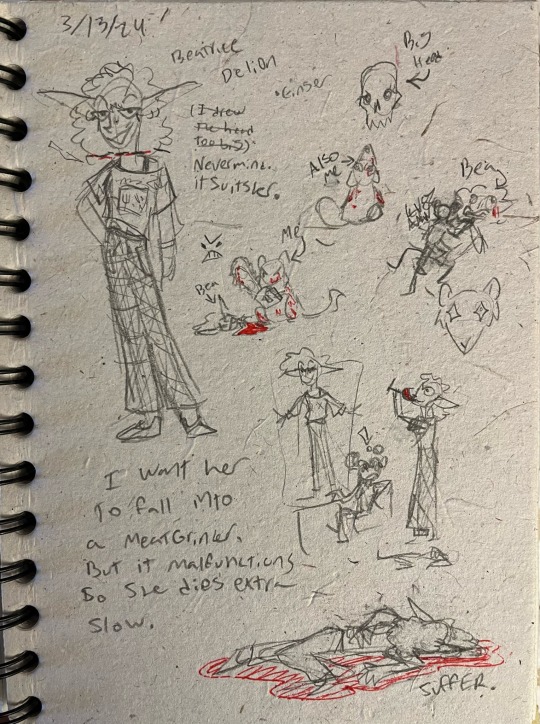

Also, an old picture of Felicity:
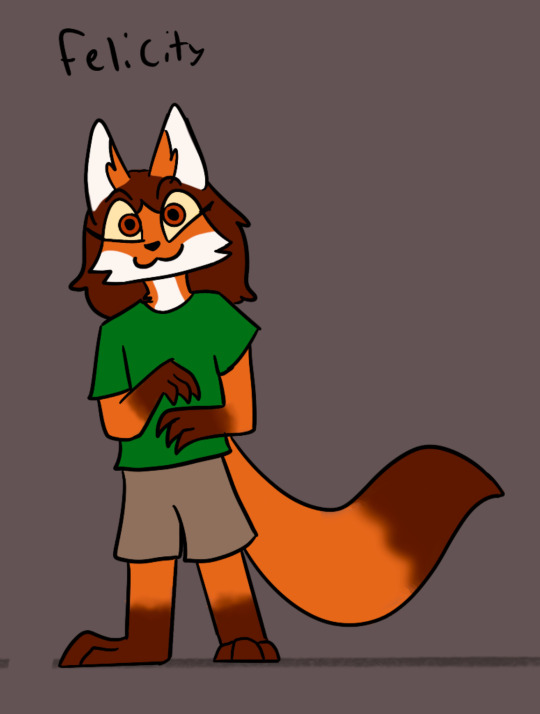
Sorry if any of this is worded weird, im not that good at talking, but could you please give a solid description of the major/cool characters in Unto Dust?
(And in case I didn’t say it before, the Comfort of Agony is SO WELL WRITTEN there is too much for me to say about it!)
Oh wow, this is all so kind of you to say! Thank you so much - I'm so glad to hear you enjoy my writing, and I love the sketches you've done! You already have a lot of great designs and the characters look super expressive!
It's really exciting to be asked more of what my characters look like and I'll give you the best description I can, but I do want to note I often don't have a clear idea of what my characters look like - I like that writing lets a reader come up with their own spins on what a character looks like! So while I'm adding my own interpretation of my characters here, if you have a different idea you think works better or just looks cooler to you, I say go for it!
I'll organise my thoughts by each character:
Darceus: I was definitely inspired by @feferipeixes' character Felicity to make a kitsune character! I really like the mane idea you have going in your sketches, and female lions do occasionally grow manes! I like the way you've drawn her formal attire, with the nine tails spread out behind her like a sort of cape! You really brought her to life!
I probably still imagine her with a fox's colouration - I liked the lion imagery to evoke the broader facial features and just overall stockier build than an average kitsune.
The nieces: They're probably both young adults of average height. I don't have a clear idea of what they look like, but it might be fun to draw them as a different type or species of fox - silver foxes look really pretty with distinctive markings! They probably have less tails than Darceus, maybe three or so.
June: I definitely had the idea of her being average sized - I think writing it from Lucy Ann's perspective makes her seem taller as a lot of characters have to look down on her (sorry Lucy Ann!). I really like the wings you drew for her! She's a middle-aged lady with a little grey in her red hair, and probably likes wearing a lot of running gear - gotta train for that 10K!
Beatrice: I really like the long ears you've given her, that looks super distinctive! The loose t-shirt is really good. I probably imagine her with more of a pear shaped build with dark brown eyes and hair. If she does magic like in her appearances with Noie I like to think it'd look a lot how Mod V's elf OC Florian does it.
Also I definitely am looking for Lucy Ann to start wearing a glove! I'm not sure whether it would be fun to have it be a red glove to match the rest of her outfit, or if it's black or some other clashing colour to illustrate how she sees it as something unwanted and forced upon her.
That's all I can think of, but if you'd like anything more specific I'd be more than happy to help! Thank you again for this ask and your awesome sketches - if you end up drawing anything else I'd really love to see it!
Have a great day! :D
18 notes
·
View notes
Note
What does Jazaiti social structure look like, irt mothers? Or like, what role do they play
Some things to be clear on beforehand:
Child: a young Jazait is considered functionally genderless and occupies this age-gender group until puberty. A child is classified as a man when testes descend (though occupies a secondary ‘young man’ space until full completion of puberty). A child becomes a woman at completion of baseline female puberty (having a fully developed mane and having undergone a growth spurt). Man: gender assignment for adult individuals with a penis and testes. They will be wed to mothers. Woman: gender assignment for adult individuals with vaginas who do NOT have active estrus cycles. Most will remain women throughout their lives and be unwed, some will become mothers. Mother: gender assignment for individuals with vaginas who DO have active estrus cycles (considered a mother regardless of if they have actually had children or not). A woman can become a mother and all mothers were once women, but these are distinct and separate gender roles. Elder mother: not a specific gender role- a post-fertile mother who no longer has an active estrus cycle. Clanmother: not a specific gender role- the current eldest mother in any given clan, who acts as its leader.
In typical elowey development, sexually mature males + nonreproductive females are minimally dimorphic, and sexual traits apart from genitalia are usually indistinct. Average size and build is approximately the same, females tend to have larger cuspids. The most strongly dimorphic feature is in scent, with most adult males and females having distinct smells.
Reproductive females on the other hand are more strongly dimorphic- there is typically an additional growth spurt and gain of body fat/muscle, voices deepen, manes grow longer and thicker, nipples grow longer and some breast tissue is accumulated (though not as much as humans, elowey only have fully developed breasts during lactation). Their scent is also distinct from males and nonreproductive females.
All elowey undergo puberty that results in an individual becoming sexually mature and physiologically capable of reproduction, but the estrus/ovulation cycles of females are hormonally suppressed by proximity of a reproductive female. A female’s estrus cycle will initiate on its own with time in the absence of a reproductive female, and will be directly initiated through sexual activity. Non-reproductive females will typically have a sex drive equivalent to a reproductive female when not in estrus- sex may be desirable in being physically pleasurable or as an act of affection, but baseline libido levels are low. Hormonal suppression cannot completely preclude the initiation of estrus (though will typically cause it to be irregular) and would be supplemented by behavioral suppression (the socially dominant reproductive female preventing others from mating) in pre-behaviorally modern ancestors. Instinct towards behavioral suppression often translates into social control of female sexual activity in elowey cultures, but this is not universal.
(^^The baseline physiology described here is universal to elowey, not just Jazait)
---
Jazait culture is mother-matriarchal, in which mothers are socially and politically dominant to men and women. All women have the potential to become mothers, but most never will, and only inherit the dominant social status upon this occurring. Being a mother is reckoned as a blessed, elevated state and one that is purely natural to occupy positions of strength and leadership, with related men and women being better suited for supporting roles and exacting her will.
Mothers have greater religious status in society and are deemed to be beings made in the sun-mother's image, who is the creator god in Jazaiti religious belief (accompanied by one other (non-creator) god, the moon-father(s), understood as one and three beings and her husband(s)). Their fertility is reckoned as being a gift from the sun-mother. This blessing extends beyond procreation and allows for mothers to work through the sun-mother to encourage needed growth and new life (in fish stocks, livestock, agriculture and forage, singing down the rains, etc). Jazaiti religion (and culture itself) is heavily decentralized, and a clanmother will be the spiritual leader of any given family group and will impart accumulated religious knowledge of generations onto her descendants.
The use of scent glands has strong applications in Jazait culture, particularly in the case of a clanmother. A clanmother will undergo a yearly ceremony in which she journeys around the limits of her clan's land and applies wrist gland secretions along the way, enforcing a protective ring that dissuades the entrance of evil spirits and forms a metaphysical boundary, a sense of 'here' and 'there'. She will also mark the faces of newborn children as means of fully initiating and accepting them into the clan. In any case where a person, place, or thing needs spiritual enforcement as belonging to a clan, this task falls to the clanmother. Any mother's scent is regarded as having properties of blessing, particularly in association with fertility.
A mother's status will generally be passed onto her eldest daughter upon completing rites of initiation, who will be wed and move out of her mothers household (thus eliminating hormonal suppression and allowing for sexual contact to more rapidly initiate estrus). The clanmother has the ultimate say in whether other daughters can become mothers, and will make this decision on a variety of factors- reading the will of the sun-mother, their own opinion on the daughter's suitability for the role, political strategy and necessity (or lack thereof) for additional marriages with another clan, and material concerns of territory and sustenance (a clan can only sustain so many families, with only the wealthiest and most powerful clans having many mothers therein).
This society has a clan system wherein the eldest mother (usually past reproductive age) has the primary and final say in the affairs of her clan. Her husbands will be considered clanfathers and have an elevated rank among other men in the clan. Clans follow a rank hierarchy of clanmother > mothers > clanfathers > husbands > women and unwed men > children.
The number of men is highly disproportionate to the number of mothers, and as such most marriages are polyandrous. One’s number of husbands is usually directly proportionate to one’s wealth, both in indicating access to resources to sustain a large family, and in practical measure, as a dowry is paid to the mother of each male spouse. Husbands will be absorbed into their wife’s clan (though this establishes ties and responsibilities with his former clan), and kinship is matrilineal and makes no distinction between children of different husbands.
A child’s biological father will often be circumstantially known, but this direct relation is not of great importance as each husband is considered a father to all associated children. Due to potential ambiguity in fatherhood and purely matrilineal descent, extramaritial affairs are not of substantial consequence and resulting children will not be considered bastards, but this this is generally frowned upon as lowly and undignified behavior.
Clans are typically very large and spread widely with clan-affiliated families occupying vast territories. Different mothers in the same clan do not directly interact on a regular basis and typically only assemble for festivities and rites, or to discuss matters of utmost importance in person. They will instead use their husbands as messengers (often one husband ends up specifically designated as a messenger, which is a loosely esteemed status as this will often indicate the greatest trust and affection).
The Jazait have no specified warrior culture (this doesn’t mean conflict is nonexistant, just that there is no strongly developed traditions surrounding it). Most women and men will have learned basic self defense and will know how to handle a spear or knife, and will fill roles of warriors in times of conflict. Mothers tend to be protected from directly engaging in combat, and will act as commanders and mediators in all but the most dire of circumstances. Mothers entering combat is a common narrative motif in Jazait storytelling and folklore, used to demonstrate the profound gravity of a conflict.
All members of a family/clan participate in childcare, with married men and mothers being the primary childrearers and the most involved in the domestic sphere and near the home (producing textiles, cooking, farm labor, etc). Women perform the majority of non-domestic labor (in traditional subsistence, this will be fishing, leviathan hunting, foraging, and some herding). This is not itself a gendered role and is partially just pragmatism- most women will go their entire lives without becoming mothers (and will thus be unmarried), while most men will be married, so there’s a greater proportion of women available for tasks away from the home.
The sexual behavior of men and especially women is strongly controlled. Men are expected to solely engage in potentially reproductive behavior with mothers, and women are expected to engage in no sexual behavior with men whatsoever (unless in the context of becoming mothers, as dictated and approved by their own). A woman who becomes pregnant without her mother's consent will technically become a mother (as this act will have been in the context of the estrus cycle self-initiating via sexual contact, and the resulting physical changes will occur), but this is deeply shameful and the theft of a great gift, and will typically result in her exile from the clan, and she and her children being clanless (conceptually close to ‘bastard’ status). This status is effectively permanent and may be socially and materially devastating, depriving the mother and child from their support network and the core unit of Jazait society. The only potential salvation occurs if the father’s clanmother makes the decision to accept the clanless child (and sometimes mother) into her own clan.
Clanless Jazait often form their own communities as means for mutual support, or may be strongly driven to turn to finding work amid other peoples as means of supporting themselves and their children. A significant proportion of Jazait who participate in Imperial Wardi society are clanless, and most established Jazait diasporic communities are at least partly Wardinized- no communities at large are fully assimilated into Wardi culture, but most participate in Wardi-esque marriage patterns as a means of sustaining their communities in this different cultural/subsistence context, and many have adopted syncretic Jazaiti-Wardi faith systems.
There is no direct stigma towards homosexual behavior, though it will be seen as more natural between women (having no other sexual outlets) than between men. While homosexual behavior itself is unstigmatized, men and mothers are fully expected to play reproductive roles in a marriage, and women tasked with becoming mothers (which will involve sexual activity with a man via their first husband) have little say in the matter.
The conceptualization of gender is a strict trinary, with no specified roles that divergence from the man - woman - mother construction. The status of intersex people depends on their variation- many intersex traits will go unnoticed or interpreted as infertility (especially due to minimal sexual dimorphism between males and non-reproductive females), and others tend to be interpreted as negative physical abnormalities.
#Kind of just became a post about gender roles as a whole but if you're still following me at this point you're here for the Paragraphs#Also should note because like. Estrus in fantasy tends to be at least a LITTLE bit of a fetishy 'I HAVE TO FUCK NOW OR I WILL DIE' thing#so like. To be clear it is NOT that wild. If you ovulate/have average libido levels and notice a higher libido While ovulating that's prett#much what it's like. Being in estrus is like your highest average day to day horniness levels while being out of estrus is like your lowest#Also might be experienced a bit like menstruation in effects on moods- one might be more irritable and prone to mood swing while#in estrus#There are some additional dimensions to it particularly in that involves perceivable physical effects- bare skin is flushed and the#anogenital region swells (this is expected to be publicly concealed in Jazaiti culture). Also one's scent changes in a way that will be#recognized as indicating fertility. All of these things will be instinctually considered Hot and someone in estrus will generally#be considered elevated in physical attractiveness.#This won't drive people into mad unbridled lust but will make the person in estrus more sexually desirable to most sensibilities.#jazait
56 notes
·
View notes
Text
Fun facts about the human body (for authors)
I collect weird facts for reference as I write, and I figured they might be useful to more people than just me. So here are a bunch of them, especially useful for murder mysteries, thrillers, and other spooky type stories:
Parts That Grow (or Don’t):
- Human hair (the kind that grows from your scalp) grows about a half inch per month. That’s six inches total a year.
- Fingernails grow 2.5-3.5 millimeters per month. Toenails grow at about half this rate.
- Fingernails grow faster in summer than in winter.
- Hair and fingernails do not grow after death. It is merely an illusion caused by the skin shrinking back.
- It’s a myth that your eyes stay the same size from birth to death. The diameter of the eye of a newborn is about 16.5 mm, while that of a full grown adult is about 24 mm.
Injuries:
- Bruises usually fade after two weeks.
- A broken bone usually takes 6-8 weeks to heal, but it varies from bone to bone. Hand and wrist fractures often heal in 4-6 weeks whereas a tibia fracture may take 20 weeks or more.
- A concussion is not a "convenient time-out" for someone who's bothering you. Every time a person is knocked unconscious, they are at risk of dying.
- It’s a myth that a concussion victim needs to be woken up every two hours, but they should be under constant supervision in case they stop breathing. They've had a traumatic brain injury and need rest. Waking them up will not help them, but you should still make sure they don't die.
Survival:
- The generally accepted rule of survival is that a person can go three weeks without food, three days without water, or three minutes without air, but these are only estimates and depend greatly on other variables.
- Though incredibly rare with the modern American diet, after about a month with no vitamin C, a person can develop scurvy, the old-timey pirate disease. It starts with lethargy and malaise, and after a few months of poor diet can move on to easy bruising and loss of teeth!
- LD50 is a term referring to the amount of a substance that has a 50% chance of causing death. This is a handy way to Google the average lethal dose of any substance. For example, the LD50 of caffeine is estimated between 150 to 200 mg per kilogram of body mass.
Death:
- People’s eyes often do not remain closed after death. Morticians have a special tool that goes under the eyelids to keep them closed for viewing at a wake.
- The stages that follow shortly after death are: corneal opacity (clouding of the eyes), pallor mortis (paleness of the skin - happening with 15-25 minutes after death), algor mortis (reduction in body temperature, which steadily declines), rigor mortis (when the limbs become stiff and difficult to move - typically lasting no longer than 8 hours at “room temperature”), livor mortis (blood settling in the lower portion of the body - starts in about 29-30 minutes), and putrefaction (the beginning of decomposition).
#writer things#human body#fun facts#biology facts#i look up the weird stuff so you don't have to#reblog to save a writer
22 notes
·
View notes
Text
File: The Nightmare Before Christmas
SCP#: AKX
Code Name: The Realm of Holidays
Object Class: Euclid Neutralized
Special Containment Procedures: Originally SCP-AKX was declared uncontainable but also a non-hazardous threat on all aspects especially to the veil over the anomalous world. However, after the 1993 incident the Department of the Impossible was asked to forever seal the connection between our realities. The Department of Universal Affairs is responsible for handling any issues that may arise in regards to multidimensional organizations as well as other Groups of Interest that handle the affairs of holidays and spirits.
Description: SCP-AKX is an alternate reality attached to our own filled with the spirits of the seven celebratory holidays. The basis of this reality is a seemingly endless forest that one can surprisingly never get lost in as it always leads back to the seven main trees in the middle. Those trees stand taller than any other, each carved in seven doors with each one taking the shape of the symbol of their holiday. Said holidays being the 4th of July, Valentines Day, Saint Patricks Day, Easter, Thanksgiving, Christmas, and Halloween. It is unknown why these doors don’t correspond with the actual order of the holidays very well. Regardless, entering any of these trees will take you to a world where that single holiday is all the focus by every spirit within.
Each world is basically a pocket dimension that only extends to be as large as the average town. Each one is labeled based on their holiday that being SCP-AKX-Fireworks, SCP-AKX-Valentines, SCP-AKX-Patrick, SCP-AKX-Easter, SCP-AKX-Thanksgiving, SCP-AKX-Christmas, and SCP-AKX-Halloween. Within each city like reality there are citizens which are actually holiday spirits and shockingly have physical forms just like SCP-AJO. As is typical of Spirit Class entities they always follow a certain theme which in this case is obviously the holidays they are assigned too. Despite each citizen belonging to one of seven different cities they are all labeled SCP-AKX-Workers. Their name is derived from the fact that all they like to do is celebrate their assigned holiday and when the holiday is over they merely get started on preparing for the next one.
Each city seems to have a corresponding leader that also acts as a mascot for the assigned holiday. For SCP-AKX-Fireworks it's a man with a flashy multicolored suit and almost Elvis-like hair with odd blue skin named John Firewood the Firework King. SCP-AKX-Valentines it's obviously the cupid in the most traditional sense as he appears to be a baby holding a bow and arrow filled quiver but talks like an adult. SCP-AKX-Patrick again it's obviously the leprechaun who unlike normal Leprechauns encountered by the Foundation is awfully generous in giving his treasure though it always turns out to be chocolates wrapped in gold. He’s also been noted to have a bad drinking problem that gets worse on the holiday of Saint Patrick's day. SCP-AKX-Easter is the Easter Bunny, a large pink almost human sized bunny that loves chocolate. SCP-AKX-Thanksgiving is actually a stereotypical Pilgrim with brown hair, blue eyes, and European ethnicity called the Turkey King. Shockingly he has a wife who is a stereotypical Native American with tanned skin, black hair, brown eyes, with the US stereotypical female native american leather dress and feather crown on her head called the Turkey Queen. Yet another holiday spirit that unfortunately follows less than historically accurate themes. Though its still quite interesting how this one has two spirits as rulers rather than one.
SCP-AKX-Christmas obviously has Santa Claus and is shockingly one of the best iterations of the holiday mascot besides the one tied to SCP-ACO. He is surprisingly strong, devoted to his job, extremely fast as well as efficient, and even defeated SCP-4666 once. Then finally there is SCP-AKX-Halloween ruled by Jack Skeleington the Pumpkin King. Quite possibly the most festive of them all as Jack Skelington is always coming up with new ideas to make Halloween more exciting.
SCP-AKX was discovered in [Data Expunged by Order of the O5 Council] when SCP-4666 was going on yet another rampage through Christmas night, kidnapping some children and tormenting the others with horrific presents. However, unlike the SCP-4666 we all know now who only attacks 30-20 houses per year, this time SCP-4666 attacked over [data expunged] hundred houses within the night. As a result Santa Claus of SCP-AKX-Christmas appeared and struck him down rather easily, he then rescued the children and took those that he could home and healed their families. For those that no longer had a home to go to he took them to good orphanages, left notes for the authorities, and gave presents to the children including framed pictures of their families to help them remember the good times. Afterwards the Santa Claus of SCP-AKX-Christmas disappeared without a trace.
The Department of Universal Affairs was assigned to find his whereabouts and sure enough he was discovered thanks to a DHS Drone. However not only was the location of this Santa Claus located but the rest of SCP-AKX. It was actually thanks to the Dimensional Hopping Surveillance Drone that the Foundation knows anything about SCP-AKX or its inhabitance.
Originally this was thought to be the end of it but unfortunately in 1993 Jack Skelington of SCP-AKX-Halloween went on his own chaotic run. During December 25th of Halloween, he kidnapped the Santa Claus of SCP-AKX-Christmas and took on his role of giving gifts to the world. Unfortunately, due to both his SCP-AKX-Workers and himself not comprehending anything outside of Halloween they did not make toys of joy but instead made tiny monsters that loved chasing and terrorizing children. Perhaps a simple accident but one that nearly ripped the veil over the anomalous world apart as several of the toys were displaying clear anomalous properties.
Due to the situation quickly getting out of control the Department of the Impossible was asked to erase all the toys and destroy all memories of them existing, which the DI did rather easily. According the the DHS Drone provided by the DUA Jack Skelington quickly realized his mistakes and went back to not only set his own dimension right but free Santa Claus. Granted this would have allowed things to go back to normal but the O5 were not willing to take the risk and thus ordered the DI to separate our realities for good.
This unfortunately led to much anger from various other holiday spirits as well as organizations that manage said spirits including SCP-AJO herself who was especially mad and tried to defend her friend Jack Skelington. As such the Legal Team of the Department of Universal Affairs - "Beyond Comprehension" Management Division has been working overtime to ensure the Foundation doesn’t have to pay any expenses that obviously can’t be paid. It should be noted that scenarios like this are exactly why the Department of the Impossible must never be relied on heavily and saved only for the most difficult to achieve tasks.
.
SCP: Horror Movie Files Hub
#DZtheNerd#SCP: Horror Movie Files#SCP: HMF#SCP Foundation#SCP Fanfiction#SCP AU#SCP#SCP Fanmade#The Nightmare Before Christmas#Cartoon#Stop motion#Holiday#Halloween#Christmas#Movie#Classic#Childhood#Wholesome#Slight Horror Elements#SCP-AKX#Neutralized#SCP-ACO#SCP-AJO#jack skellington#Santa Claus
5 notes
·
View notes
Note
What would be the proper enviroment to raise a furby up? [start from the egg state please]
To start, I would suggest you have multiple eggs as it is almost impossible to tell which eggs of the brood have been fertilized/are viable. I also suggest this as Furbies tend to have a higher quality of life if they are raised with at least one other litter mate.
The eggs (sometimes referred to as Orbeez by breeders) should be submerged in clean warm water. Boiled water will do nicely (that’s boiled water not BOILING water, adding the eggs to actively boiling water will cook them. It is important to make sure the water isn’t too hot before adding the eggs. You may put a drop of water on the back of your hand to test it, much like preparing baby formula). To maximize hatch rate the water should be changed daily. The eggs start out very small, but will grow to be approximately the size of a golf ball before hatching.
From time of laying, it usually takes 10 days for the eggs to hatch. Depending on the specific breed and/or health of the mother, the eggs may hatch sooner or later. You will know that they are about to hatch by the significant movement of the worm within the egg. It is important to transfer the worm into a warm, dry place so that it can dry off its fuzz, otherwise it may become sick or freeze to death. In nature, the eggs that fail to hatch are typically eaten by the mother, but if you are raising them completely on your own you may dispose of the unhatched eggs however you wish.
In nature the mother uses her beak to grind up small berries and leafy greens to feed her worms as they have no beaks or teeth to process their own food yet. You may achieve this yourself by using a mortar and pestle. A blender can also do in a pinch, but remember that it should have the consistency of a paste, not a liquid. Insects should not be fed to the worms as they cannot digest proteins or meats. Yet.
Their enclosure should be warm, dry, and well lit. You should make sure you have enough room for the amount of worms you have. On average, worms require two square feet per worm to properly develop. There should also be lots of toys and structures for them to interact with. Worms are very curious and playful and they love to climb and hide. They also should be frequently played with directly so that they become accustomed to human beings. They should be spoken to often. While they do not yet have the capacity to communicate back to you, they can understand.
This larval stage lasts for another 10 days, and if all goes well they will transition into the cocoon making stage. The crafting of the cocoons will happen very quickly, with some breeders finding that their entire litter completed their cocoons overnight. The cocoons resemble large eggs, both in shape and in the thickness and texture of the “shell.”
The worms will remain in their eggs for another week or so, after which time they will hatch. These new hatchlings are sometimes called Furby Babies (or sometimes Furblings, depending on the breed). The Furby Babies are very intelligent and will start speaking Furbish right away and, if correctly socialized as worms, should pick up human languages quickly.
The diet of the Furby Baby will now be like that of the adult Furby, human skin and blood. The process is painless and should not cause any health problems for the owner. Place your finger into the mouth of the Furby and allow it to coat your finger in a fine layer of its saliva (sometimes called venom). The saliva contains chemicals that will numb your finger so you will not feel it scrape off the small area of skin that it needs. The Furby is actually capable of producing two different salivas, the first saliva that contains the numbing agent also contains an anti coagulant so that it may lap up a small amount of your blood uninterrupted. The second saliva is produced once it is done feeding and promotes the wound to quickly heal so that it doesn’t get infected. The meat and/or blood of other animals cannot be used as substitutes. Only human blood can sustain the Furby now.
With love and care, the Furby Baby will soon finish developing and mature into adulthood. From here on, the treatment and care of the Furby will be much like that described in the manuals that are distributed upon purchase of a full grown adult Furby.
Should you form a bond with your Furby, it will be a good friend to you for many many years to come. However, if you do not form a bond with your Furby, it will leave, revert to a feral form, and return to A-Loh May-Lah to become an Elder.
Hope this helps :)
52 notes
·
View notes